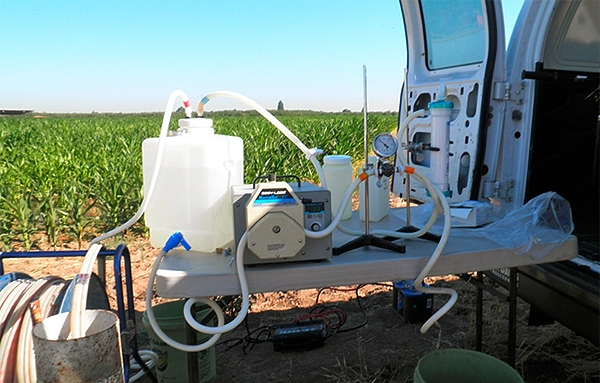
Groundwater wells can fail in many ways. Sometimes the water table sinks below the level of the well. Sometimes minerals cause buildup in well systems. And, sometimes, wells get clogged with lots and lots of microbes.
Microbes can form large, jelly-like mats that lead to well failure from what is known as biofouling. Biofouled wells can be both expensive and technically challenging to repair. There are even times that repair is not possible and replacement is the only option. In Washington State, for example, researchers have encountered well pipes completely clogged by mats of bacteria. While this level of biofouling has not yet been found in California, nobody has really been looking either. Until now.
Researchers Clarissa Nobile and Aaron Hernday of UC Merced, along with UC Berkeley colleague Will Ludington and Glen Wallace with the Pacific Groundwater Group, have been taking a new, interdisciplinary approach to researching biofouling as a potential problem for groundwater wells in California. Using metagenomics – a genetics-based method where samples are taken from the whole environment versus a single organism – they are hoping to gain a better understanding of how big a challenge biofouling might be in California so that problems can be detected early.
Already, they know that differences between the chemical conditions in groundwater and surface water can lead to biofouling. Nobile says that this is because microbes like to have “diverse places they can grow and survive – the more similar the water conditions, the fewer ways microbes have to thrive.”
In addition, the researchers say that well building and operation can play a part in how quickly biofouling might occur. For example, groundwater declines are a familiar problem in California's Central Valley, compounded by the ongoing drought. Wallace notes that “as water users drill into deeper aquifers, they are more likely to encounter reduced oxygen conditions that can lead to microbial growth and present maintenance problems in the future.”
Microbes can affect water quality positively, like when they are used to remove contaminants. At the same time, they can also lead to challenges with water smell and taste. For example, says Ludington, “the musty flavor you associate with soil or pond water can be caused by geosmin, a common and rather stinky secondary metabolite produced by many microbes.”
It is important to note that most of the microbes associated with biofouling are not pathogenic. “Microbe problems that are a concern for health are usually coliforms, which the EPA requires testing for in public supply wells. Because of that baseline testing, it is unlikely that we would discover anything new regarding health concerns at those wells.”
The project is still in its early stages and getting access to wells that the research group can study has proven difficult in California. Nobile says that while having Wallace, a Pacific Northwest groundwater specialist, on the team helped get access to field sites in Washington State as part of a larger study, it's been a slow start here. She notes that “over the long term, this type of project is a win-win situation, so we are still actively seeking out well owners willing to provide access for sampling.”

The fieldwork itself is time consuming. “At one Central Valley dairy, we were sampling well water from monitoring wells that a dairyman had allowed us to access. To get a sample from a clean well, we had to pump around 25 gallons of water through a kidney dialysis filter to concentrate the biological material we need. This pumping and filtering process can take up to eight hours to concentrate the sample for analysis at the lab.” They are beginning to experiment with new sampling approaches that they hope will speed up the process.
The researchers say that one of the goals of the project is identifying what combinations of geologic settings, well conditions, and microbial communities are problematic. Wallace says that as a groundwater hydrogeologist, “it has been surprising to see the depth of information that the metagenomic analyses provide. Compared to some of the related tools used in industry, it is the equivalent of moving from a slide rule to a powerful computer.”
Using these cutting edge tools, the research team hopes to identify chemical signatures that are indicative of biofouling. Ultimately, the goal is to develop routine monitoring procedures to assess the risk of biofouling – before it leads to expensive maintenance or well replacement.
This research was supported in part by a grant to principal investigator Clarissa Nobile from the California Institute for Water Resources in the University of California's Division of Agriculture and Natural Resources.